“What’s in a name? That which we call a rose by any other name would smell as sweet.”
With apologies to the Bard I must disagree with Juliet. I think names matter and there’s almost no rhyme or reason for the name of this duck.
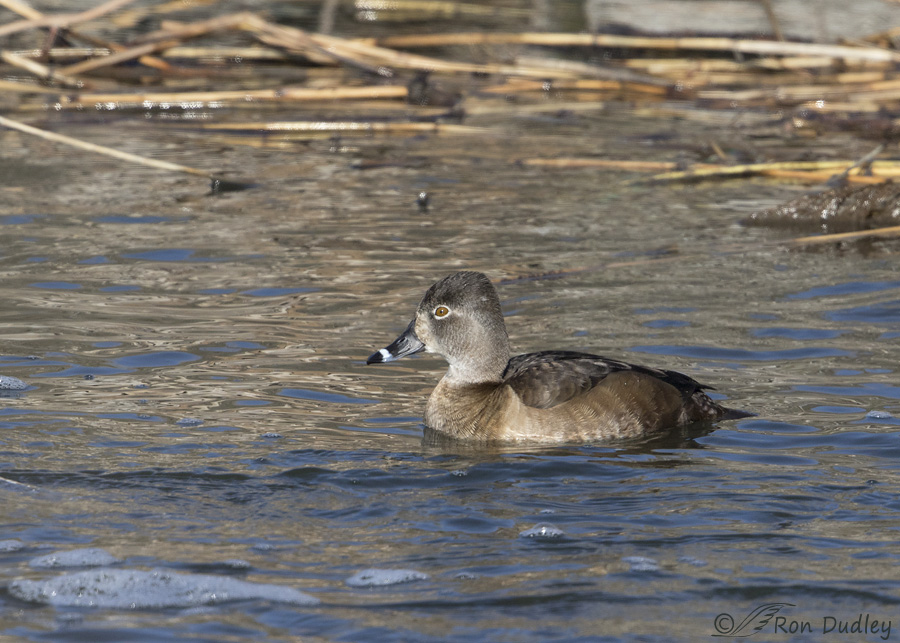
1/3200, f/7.1, ISO 500, Canon 7D Mark II, Canon EF 500mm f/4L IS II USM + EF 1.4 III Extender, not baited, set up or called in
I don’t get many chances with Ring-necked Ducks, especially the females for some reason. But six days ago while I was photographing Common Goldeneyes on the Jordan River I glanced up from my viewfinder to find this female reasonably close and checking me out.
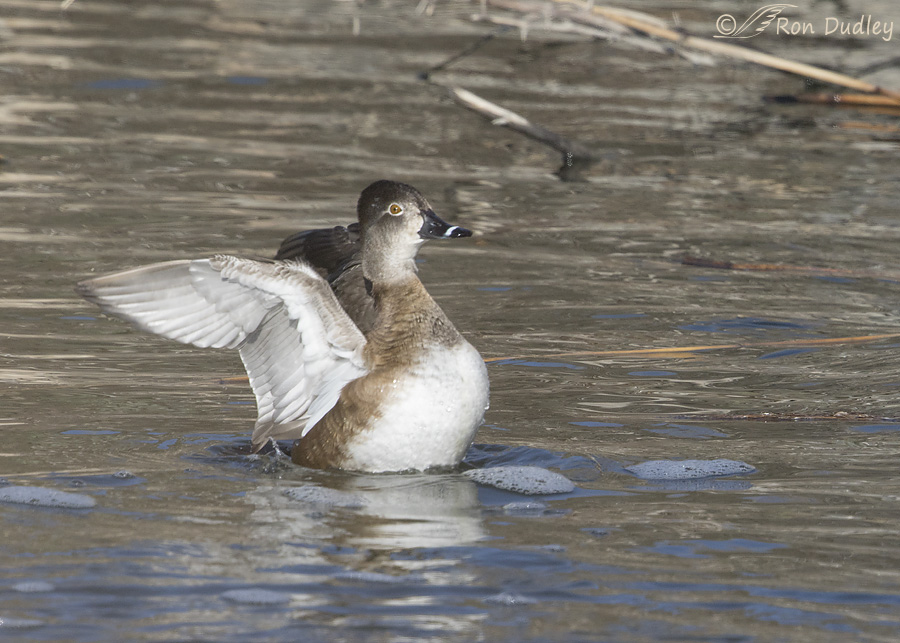
1/3200, f/7.1, ISO 500, Canon 7D Mark II, Canon EF 500mm f/4L IS II USM + EF 1.4 III Extender, not baited, set up or called in
She wasn’t very active but she did give me a nice wing flap at a pleasing angle in good light…
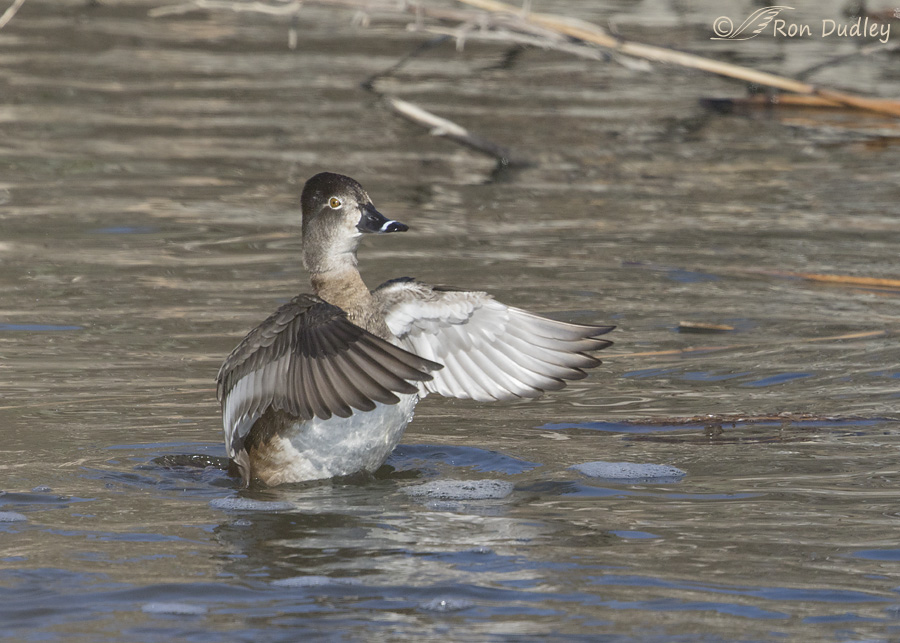
1/2500, f/7.1, ISO 500, Canon 7D Mark II, Canon EF 500mm f/4L IS II USM + EF 1.4 III Extender, not baited, set up or called in
and these two shots of it were my favorites. Then she settled back down in the water and just stared at me so I went back to the goldeneyes.
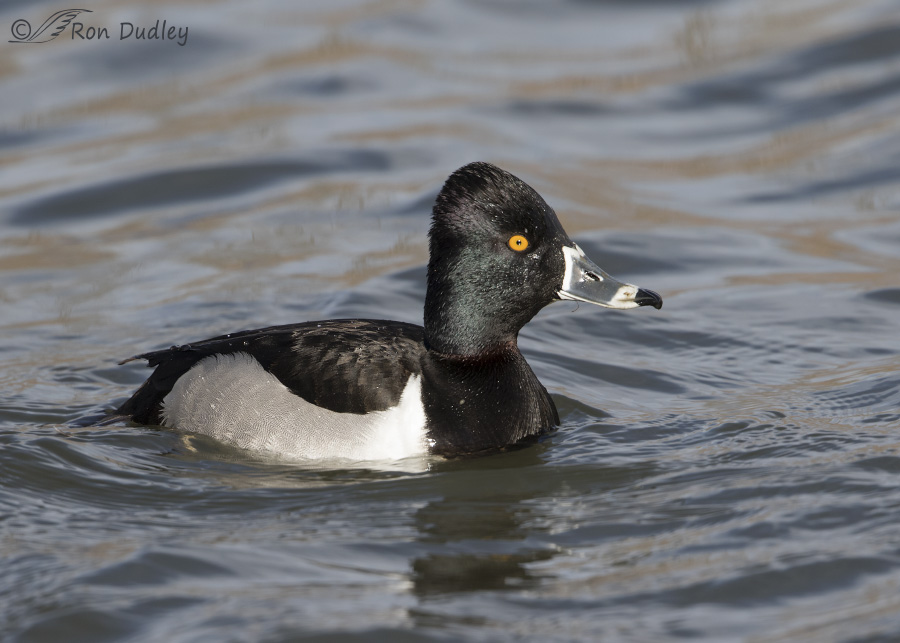
1/2000, f/6.3, ISO 500, Canon 7D Mark II, Canon EF 500mm f/4L IS II USM + EF 1.4 III Extender, not baited, set up or called in
The previous year I’d been able to get much closer to some males. They’re best identified by their distinctive triangular white wedge extending upward in the area in front of the folded wing and a short crest that gives its head a very peaked and angular profile unlike that of any other North American Duck.
So, where’d the “ring-necked” part of the name come from? Males have a very inconspicuous narrow, dark-chestnut collar around their neck but it can usually only be seen if:
- there’s bright light on the duck
- the viewer is close
- the head is raised and the neck extended in an “alert” position
If you look carefully that ring can be seen in the photo above but I had to browse through dozens of my own images before I found one where it could be seen this well. In the field with the naked eye it’s usually not seen at all and many birders have never seen it. It’s a terrible field mark for identification but it jumped out to the nineteenth century biologists who described the species using dead specimens so that’s where the name came from.
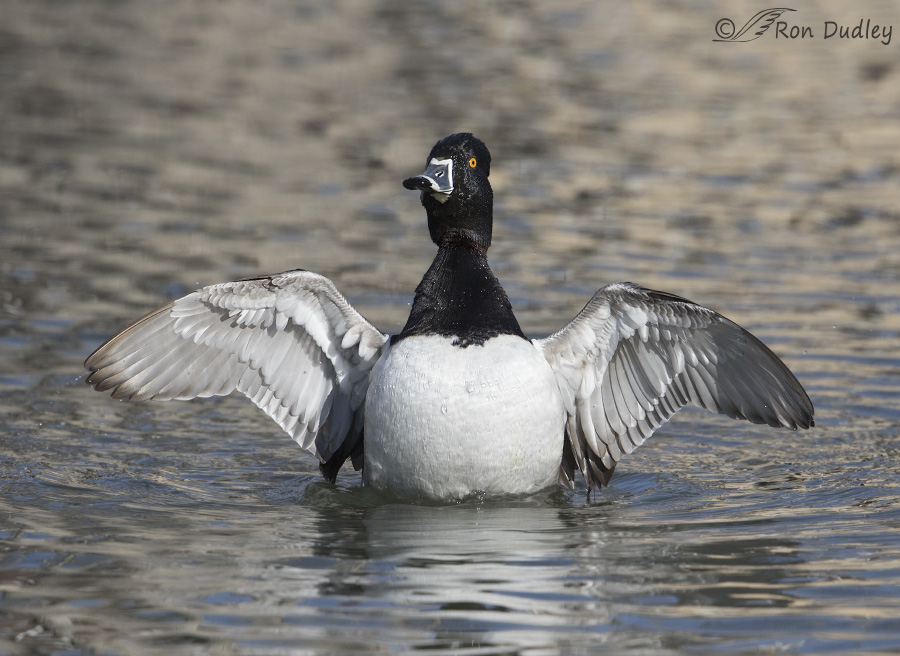
1/5000, f/6.3, ISO 500, Canon 7D Mark II, Canon EF 500mm f/4L IS II USM + EF 1.4 III Extender, not baited, set up or called in
This photo should give you an idea of how difficult the ring is to spot in the field. I was very close to this bird in bright light and his neck was extended but the ring is next to invisible. If you squint you can get some hints of it but not much more.
A much more appropriate common name for this species would be Ring-billed Duck. If you review the previous images you’ll notice that this species has a conspicuous white band or ring bordered with a black tip on the end of its bill, a characteristic shared by all sexes and ages. Generations of hunters have referred to this species as “ring-bills” for good reason. Ring-necked Duck may seem like an appropriate name if the specimen is laying in front of you on a museum tray under bright lab lights but in the field it seems to me (and to many others) that the name serves no useful purpose and can even be misleading when the supposed neck ring can’t be observed.
So, as I suspect some of my readers already know, it’s likely that the name of this duck is about to change. The American Ornithologists’ Union (AOU) now has a proposal before it to change the name from Ring-necked Duck to Ring-billed Duck. Personally I support the proposal.
Its scientific name will still be Aythya collaris with the “collaris” species name referring to the neck ring so I hope that’s enough for the traditionalists.
Ron


Fantastic series Ron! I’ve often wondered this myself.
Charlotte
Love, love, love the second and third shots.
And have frequently thought that avian names were obviously a result of ‘committee think’.
You may be right, EC – perhaps some of them are.
Rats! I snoozed; I loozed. Dick beat me to the “a duck is a duck is…” take.
I found, during my brief foray into the world of research and academia, that the ease of change in the scientific community, be it nomenclature or taxonomy, varies widely depending on the personalities of the particular group of people involved. (And here are a few extra commas in case I didn’t sprinkle them liberally enough in the previous sentence: ,,,,, ) 😉
Ron, those wing flap shots are fabulous! Such an interesting-looking species no matter what it’s called!
P.S. If the crest was any bigger, they could be called the “Don King Duck.”
I love your comments, Marty – they’re always interesting and they often tickle my funny bone.
Lovely shots of a beautiful pair!
Rick Wright had an interesting article in the May/June 2014 issue of Birding magazine discussing just this. He searched out the description of the original type specimen (by Edward Donovan, Natural history of British Birds, 1809) and found the only mention of the bill was “the bill and legs dusky,” while the engraving had no special markings either. The duck Donovan used for his description was from a poultry market, so who knows what happened to it in transit – perhaps the bill was damaged or even destroyed when it was shot. So he didn’t have much to go by as an identifiable name! though I like the old-time hunters’ name of ‘Silversides’.
Unfortunately the article is only visible in their online archive if you’re an ABA member.
What a fascinating story, Naomi.
From what you said it sounds like the type specimen was found in the UK. If so that surprises me since it’s my understanding that the species is primarily North American (although in recent years sightings elsewhere have become increasingly common).
Thanks, Naomi. Anyone who wants a pdf of that essay can drop me a line at rwright@aba.org. Ron, the type locality is Lincolnshire.
As long as we are complaining about bird names! I don’t like it when the name includes “common”. It is unnecessary unless we are differentiating from an “uncommon” and who says they are “commoon anyway. I also never like it when we stick a person’s name on a bird species. Seems disrespectful. There… Now I feel better! But in the end, I’m sure the ducks dont care at all.
Porcupine.
I’m sure you’re right about at least one thing, Porcupine – there will be no duck-sleep lost over this tempest in a teapot.
Interesting that there should be such a fuss over changing the common name of a species. Obviously it makes sense to change it, but it seems strange that scientists can apparently easily change taxonomic categories (I’ve discovered that a lot of plants that were in one family when I studied botany have been moved to other families), but that it takes a greater effort to change a common name. That’s just my take on it; don’t know how it really is. We had the pleasure of seeing Ring-necked/billed Ducks at Hueco Tanks in 2013 when we developed a large lake after getting 3.5 inches of rain in one day. It was fun to watch them.
Susan, Bird folk are notorious for making a fuss over such things! 🙂
Ron,
Although I haven’t commented much on your posts I read them and enjoy them every day. Thank you for your efforts in educating us!
Regarding the ring-necked duck, I’m happy to hear about the possible name change. I was wondering if Eastern varieties of this bird have a more obvious ring on the neck (as you said, only if the neck is extended.) I wonder about that because I do have one photo of the ring-necked duck where the ring is quite obvious. I notice in my Lightroom settings that I did increase the exposure and shadow brightness, so this may not be a valid representation. But maybe it is.
Do you know if Eastern Ring-necked ducks have a more obvious ring?
“Do you know if Eastern Ring-necked ducks have a more obvious ring?”
No, Den, I don’t know that one way or the other.
What I do know is that increasing brightness on the darks or “shadows” during processing can make colors like these stand out significantly more than in the unprocessed image. I’ve noticed it on the colored iridescence of quite a few species including these ducks, Common Goldeneyes and Black-billed Magpies.
Great shots! Love the wing-flap your female provided.
I always say: “If it walks like a Ring-billed, talks like a Ring-billed and looks like a Ring-billed then it MUST be a Ring-billed!”
(A-O-Who?)
“(A-O-Who?)”
Wally, with all the merging going on lately involving the AOU, COS and AOW I never know what to call them!
And it was Gertrude Stein (agreeing with Shakespeare) who said, “A Ring-necked Duck is a Ring-necked Duck is a Ring-necked Duck”. Or something like that…
Cheers,
Dick
Ha, or “something like that”…
This is true with other bird names as well. Red-bellied Woodpecker has always bothered me. If the AOU changes this ducks name I am sure it will be well received.
You’re shots show well the characteristics of the female and male relative to the ring on the bill of the female and the wide white band on the bill of the male as well as the marked white wedge on the males side which are all indicative of this species.
Lets hope that the AOU makes a positive decision.
Dick, I’ve heard others complain about the name of the Red-bellied Woodpecker too. I’ve never seen one so I haven’t thought about it much.
Red-bellied woodpeckers have bright red heads and a small, slight smear of light rosey (almost pinkish) red on their breast…hard to see most of the time…(unless you’re snockered and also seeing pink elephants)…
Cotrection That smallmreddish smrar is on their bellies, not their breasts…sorry! Alternative facts…. :-/
I wonder if those there heffalumps are parboiled, sunburned or just natcherlly that color???
I had to chuckle at your alternative facts……. 🙂
However, North America already has a Red-headed Woodpecker and red on top of the head shouldn’t be construed as red-headed. Maybe red capped or some other name that would pull out a characteristic that would help people to identify this woodpecker. The slight pink tinge to the belly just isn’t enough red color to call it red-bellied, even when looking at one with bins.
I do like Ring-billed Duck though.
Great Pictures as always and yes never could figure out why they are called ring neck ???? Good idea to change name .. like ring billed it’s always how I identify them.. thank you for info Ron the teacher wii always teach…
Thanks, Marina. It’s in my blood…
Are you sure that isn’t “wringed-neck Duck”??? ‘Cause I certainly don’t see no neck ring!! I see a nice, bright one around the end of the bill…maybe it slipped, or maybe its ring was too small for its neck so it wears its ring around its bill instead. Love the images, though, especially the first two and the last…the water is interesting in all of them. Like clams, ducks always look like they’re smiling…
Make that second and third shots….
I hope the name change is accepted Patty, for the reason you refer to so uniquely.
Welllllll Ringed bill duck might work! 🙂 Beautiful series of photos whatever it’s “name” is. Beautiful duck and the photos do them justice. 🙂
Thank you, Judy.